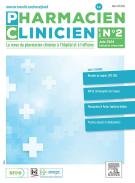Bilan d’utilisation d’un logiciel de ciblage des prescriptions des patients à risque pour l’analyse pharmaceutique - 25/11/22
Assessment of the use of software for targeting prescriptions of at-risk patients for pharmaceutical analysis
 , Rémy Basso Boccabella 2, Julien Voyat 1, Laurence Ferrier 1, Grégory Rondelot 2
, Rémy Basso Boccabella 2, Julien Voyat 1, Laurence Ferrier 1, Grégory Rondelot 2Cet article a été publié dans un numéro de la revue, cliquez ici pour y accéder
Résumé |
L’objectif de cette étude est d’évaluer le bénéfice apporté par un outil de ciblage des patients à risque au cours de l’analyse pharmaceutique dans notre pratique quotidienne. Pour cela, nous avons testé le logiciel VIDAL sentinel® (VS). Dans un premier temps un seul pharmacien a utilisé l’outil à la suite d’une analyse pharmaceutique réalisée en amont par un pharmacien différent sans VS. Dans un second temps, plusieurs pharmaciens l’ont utilisé à la suite de leur propre analyse pharmaceutique traditionnelle. Le premier test a abouti à l’analyse de 217 prescriptions à l’aide de VS et à la génération de 24 interventions pharmaceutiques (IP) supplémentaires. Le second test a porté sur 1183 patients à risque d’après le logiciel. Vingt-neuf IP supplémentaires ont été formulées. Ce travail a montré que VS permettait l’identification de problèmes médicamenteux qu’une analyse traditionnelle ne permet pas. Le logiciel va désormais être utilisé par chaque pharmacien avant son analyse pharmaceutique pour cibler les patients à risque. En cas de manque de ressources en personnel, un pharmacien analysera à minima les prescriptions des patients à risque présents dans le logiciel.
Le texte complet de cet article est disponible en PDF.Summary |
The aim of this study is to evaluate the benefice provided by a tool for targeting at-risks patients during pharmaceutical analysis in our daily practice. We tested the VIDAL sentinel® (VS) software. First, only one pharmacist used the tool following a pharmaceutical analysis carried out by a different pharmacist without VS. Then, several pharmacists used it following their own traditional pharmaceutical analysis. The first test leads to analyze 217 prescriptions with VS and to generate 24 additional pharmaceutical interventions (PI). The second test was made on 1183 considerate as high-risk patients by the software. Twenty-nine additional PI were generated. This work showed that VS allowed the identification of drugs problems not allowed by traditional pharmaceutical analysis. The software will be used by every pharmacist before the pharmaceutical analysis to prioritized the high-risk patients. Even if there is a lack of pharmaceutical staff, a pharmacist will analyze at least the prescriptions of the high-risk patients.
Le texte complet de cet article est disponible en PDF.Mots clés : Analyse pharmaceutique, Ciblage des patients à risques, Erreur médicamenteuse, Intelligence artificielle
Keywords : Pharmaceutical analysis, Targeting high risk patients, Medication error, Artificial intelligence
Plan
Bienvenue sur EM-consulte, la référence des professionnels de santé.
L’accès au texte intégral de cet article nécessite un abonnement.
Déjà abonné à cette revue ?

